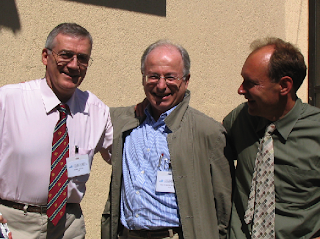Chauvet-Pont-d’Arc Cave, Ardèche, France, discovered 18 December 1994
Elsie De Wolfe, American actress & interior decorator, birthday 20 December 1865
Joseph Olbrich, Austrian architect and co-founder of the Vienna Secession, birthday 22 December 1867
With as small as the world seems today, it may be unbelievable that in the modern era there are still prehistoric discoveries which amaze and challenge the collective knowledge. As recently as 1994, the immense cave of Chauvet with its perfectly preserved paintings dating over 30,000 years was discovered, isolated by an ancient landslide.
 What makes these images different
than those found at Lascaux? Not only
are these images over twice as old, but they show similar and in some cases
more advanced techniques. The artist(s)
prepared the surfaces by scraping away debris and sometimes older
paintings. There are images that have
been carved into the surface not just applied with paint. There are full “scenes” of action, not just encyclopedic
representations of animals. In one scene there is a dominance struggle between two rhinoceroses. Of course there are rudimentary acknowledgments of perspective and action as with Lascaux.
What makes these images different
than those found at Lascaux? Not only
are these images over twice as old, but they show similar and in some cases
more advanced techniques. The artist(s)
prepared the surfaces by scraping away debris and sometimes older
paintings. There are images that have
been carved into the surface not just applied with paint. There are full “scenes” of action, not just encyclopedic
representations of animals. In one scene there is a dominance struggle between two rhinoceroses. Of course there are rudimentary acknowledgments of perspective and action as with Lascaux.  However, the level of shading detail here evoke a
sense of three-dimensionality. With
every new discovery the understanding of the prehistoric human mind becomes
richer. The more complex these findings
are offers the opportunity to re-examine what it truly means to be human and
the need to express one’s self artistically.
However, the level of shading detail here evoke a
sense of three-dimensionality. With
every new discovery the understanding of the prehistoric human mind becomes
richer. The more complex these findings
are offers the opportunity to re-examine what it truly means to be human and
the need to express one’s self artistically.


 Joseph Olbrich along with Gustav Klimt, Josef Hoffmann &
Koloman Moser established the Vienna Secession movement in 1897 but Olbrich
gave the group what would become its figurehead: the Secession Hall. The movement sought to break from the
prevailing traditional conservatism of the Vienna Künstlerhaus which focused on
historicism. Instead, Olbrich wanted to
bring “purer” geometric forms to buildings.
This can be seen in the Secession Hall with the iconic orb atop the
structure contained by four rectangular pillars. The building surface is then decorated with
linear ornament which would come to be called “whiplash” or “eel” style.
Joseph Olbrich along with Gustav Klimt, Josef Hoffmann &
Koloman Moser established the Vienna Secession movement in 1897 but Olbrich
gave the group what would become its figurehead: the Secession Hall. The movement sought to break from the
prevailing traditional conservatism of the Vienna Künstlerhaus which focused on
historicism. Instead, Olbrich wanted to
bring “purer” geometric forms to buildings.
This can be seen in the Secession Hall with the iconic orb atop the
structure contained by four rectangular pillars. The building surface is then decorated with
linear ornament which would come to be called “whiplash” or “eel” style.  These ideas would give way to the Art Nouveau
movement which eventually formed a theoretical break in the Secession members. However, Olbrich maintained the original
ideal of the group and found extended success in the States. After participating in the Louisiana
Exhibition in St. Louis, he was appointed corresponding member of the AIA, most
likely at the behest of Frank Lloyd Wright.
It is a small wonder as the two shared similar theories on architecture
and ornamentation.
These ideas would give way to the Art Nouveau
movement which eventually formed a theoretical break in the Secession members. However, Olbrich maintained the original
ideal of the group and found extended success in the States. After participating in the Louisiana
Exhibition in St. Louis, he was appointed corresponding member of the AIA, most
likely at the behest of Frank Lloyd Wright.
It is a small wonder as the two shared similar theories on architecture
and ornamentation. Links:
The Chauvet Cave, Ardèche, France
"Cave of Forgotten Dreams", flim by Werner Herzog
The Bradshaw Foundation for ancient rock art
article on Elsie De Wolfe, Architectural Digest
"The House in Good Taste", by Elsie De Wolfe, University of Wisconsin Digital Collections
The Secession Hall, Vienna, Austria
archINFORM for the Secession Hall
archINFORM for Hochzeitsturm, Darmstadt, Germany

























.JPG)
.JPG)



















.jpg)